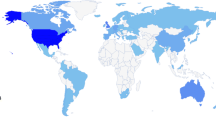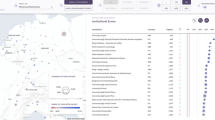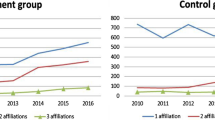Abstract
International academic awards are popular as incentives and rewards for academics all over the world, and have played a significant role in the performance evaluations of individuals and institutions. However, little is known about the relative importance of awards and the relationships between awards. This study aims to establish a comprehensive global map of important international academic awards, which visually presents the relative reputations of awards and the close or distant relationships between awards. By surveying the reputations of the preselected 207 awards, 90 important international academic awards with above-average reputations were identified. Then, based on the number of “awardees in common” or named “co-awardees” between every pair of these 90 awards, a network of co-awardees was built. Finally, using mapping software of VOSviewer, these 90 important international academic awards were mapped by taking the reputation scores as the weights of awards and the network of co-awardees as the basis of the relationships between awards.







Similar content being viewed by others
Notes
This indicator measures the weighted number of faculty members of an institution who have won, in addition to the Nobel Prize and the Nobel Memorial Prize in Economic Sciences, the following awards, medals, and prizes covering virtually all academic disciplines: Abel Prize, Balzan Prize, Charles Stark Draper Prize, Crafoord Prize, Dan David Prize, Fields Medal, Fundamental Physics Prize, Holberg International Memorial Prize, Japan Prize, Kavli Prize, Kluge Prize, Kyoto Prize, Millennium Technology Prize, Praemium Imperiale, Pritzker Prize, Shaw Prize, Schock Prize, Templeton Prize, Turing Award, Wolf Prize, and World Food Prize.
By 1983, the name of Tyler Ecology Award was changed permanently to the Tyler Prize for Environmental Achievement.
References
Best, J. (2008). Prize proliferation. Sociological Forum, 23(1), 1–27. doi:10.1111/j.1573-7861.2007.00056.x.
Billaut, J.-C., Bouyssou, D., & Vincke, P. (2010). Should you believe in the Shanghai ranking? Scientometrics, 84(1), 237–263. doi:10.1007/s11192-009-0115-x.
Börner, K., Chen, C. & Boyack, K. W. (2003). Visualizing knowledge domains. In B. Cronin (Ed.), Annual Review of Information Science and Technology (Vol. 37, pp. 179–255). NJ: Information Today, Inc./American Society for Information Science and Technology. Retrieved from http://onlinelibrary.wiley.com/doi/10.1002/aris.1440370106/full.
Charlton, B. G. (2007a). Measuring revolutionary biomedical science 1992–2006 using Nobel prizes, Lasker (clinical medicine) awards and gairdner awards (NLG metric). Medical Hypotheses, 69(1), 1–5. doi:10.1016/j.mehy.2007.01.001.
Charlton, B. G. (2007b). Scientometric identification of elite “revolutionary science” research institutions by analysis of trends in Nobel prizes 1947–2006. Medical Hypotheses, 68(5), 931–934. doi:10.1016/j.mehy.2006.12.006.
Charlton, B. G. (2007c). Which are the best nations and institutions for revolutionary science 1987–2006? Analysis using a combined metric of Nobel prizes, fields medals, Lasker awards and turing awards (NFLT metric). Medical Hypotheses, 68(6), 1191–1194. doi:10.1016/j.mehy.2006.12.007.
Cobo, M. J., López-Herrera, A. G., Herrera-Viedma, E., & Herrera, F. (2011). Science mapping software tools: review, analysis, and cooperative study among tools. Journal of the American Society for Information Science and Technology, 62(7), 1382–1402. doi:10.1002/asi.21525.
Cole, J., & Cole, S. (1973). Social stratification in science. Chicago: University of Chicago Press.
Frey, B. S. (2006). Giving and receiving awards. Perspectives on Psychological Science, 1(4), 377–388. doi:10.1111/j.1745-6916.2006.00022.x.
Frey, B. S. & Neckermann, S. (2008a). Academics appreciate awards-a new aspect of incentives in research. Retrieved from http://papers.ssrn.com/sol3/papers.cfm?abstract_id=1319323.
Frey, B. S., & Neckermann, S. (2008b). Awards: A view from psychological economics. Zeitschrift Für Psychologie/Journal of Psychology, 216(4), 198–208. doi:10.1027/0044-3409.216.4.198.
Frey, B. S., & Neckermann, S. (2009). Awards: A disregarded source of motivation. In M. Baurmann & B. Lahno (Eds.), Perspectives in moral science (pp. 177–182). Frankfurt am Main: Frankfurt School Verlag. Retrieved from http://www.rmm-journal.de/downloads/012_frey_neckermann.pdf.
Frey, B. S., & Neckermann, S. (2010). Awards as signals (No. CESifo working paper: 3229). CESifo. Retrieved from http://www.econstor.eu/handle/10419/46399.
Kessler, M. M. (1963). Bibliographic coupling between scientific papers. American Documentation, 14(1), 10–25.
Liu, N. C., & Cheng, Y. (2005). Academic ranking of world universities—Methodologies and problems. Higher Education in Europe, 30(2), 127–136.
Mahassen, N. (2014). A Quantitative approach to world university rankings. Retrieved from http://cwur.org/methodology/preprint.pdf.
Merton, R. K. (1957). Priorities in scientific discovery: A chapter in the sociology of science. American Sociological Review, 22(6), 635–659. doi:10.2307/2089193.
Merton, R. K. (1968). The Matthew effect in science. Science, 159(3810), 56–63.
Peters, H. P. F., & van Raan, A. F. (1993). Co-word-based science maps of chemical engineering. Part I: Representations by direct multidimensional scaling. Research Policy, 22(1), 23–45.
Small, H. (1999). Visualizing science by citation mapping. Journal of the American Society for Information Science, 50(9), 799–813.
Sternitzke, C., & Bergmann, I. (2009). Similarity measures for document mapping: a comparative study on the level of an individual scientist. Scientometrics, 78(1), 113–130. doi:10.1007/s11192-007-1961-z.
The US National Research Council Committee on an Assessment of Research Doctorate Programs. (2011). In Ostriker, J. P., Kuh, C. V. & Voytuk J. A. (Eds.) A data-based assessment of research-doctorate programs in the United States. Washington (DC): National Academies Press (US). Retrieved from http://www.ncbi.nlm.nih.gov/books/NBK83404/.
Van Eck, N. J., & Waltman, L. (2007a). Bibliometric mapping of the computational intelligence field. International Journal of Uncertainty, Fuzziness and Knowledge-Based Systems, 15(05), 625–645.
Van Eck, N. J. & Waltman, L. (2007b). VOS: A new method for visualizing similarities between objects (No. ERS-2006-020-LIS). Erasmus Research Institute of Management (ERIM). Retrieved from http://link.springer.com/chapter/10.1007/978-3-540-70981-7_34.
Van Eck, N. J., & Waltman, L. (2009). How to normalize cooccurrence data? An analysis of some well-known similarity measures. Journal of the American Society for Information Science and Technology, 60(8), 1635–1651. doi:10.1002/asi.21075.
Van Eck, N. J., & Waltman, L. (2010). Software survey: VOSviewer, a computer program for bibliometric mapping. Scientometrics, 84(2), 523–538. doi:10.1007/s11192-009-0146-3.
Waltman, L., Calero-Medina, C., Kosten, J., Noyons, E. C. M., Tijssen, R. J. W., van Eck, N. J., & Wouters, P. (2012). The leiden ranking 2011/2012: Data collection, indicators, and interpretation. Journal of the American Society for Information Science and Technology, 63(12), 2419–2432. doi:10.1002/asi.22708.
Waltman, L., Van Eck, N. J., & Noyons, E. C. M. (2010). A unified approach to mapping and clustering of bibliometric networks. Journal of Informetrics, 4(4), 629–635.
Zitt, M., Bassecoulard, E., & Okubo, Y. (2000). Shadows of the past in international cooperation: collaboration profiles of the top five producers of science. Scientometrics, 47(3), 627–657. doi:10.1023/A:1005632319799.
Zuckerman, H. (1992). The proliferation of prizes: Nobel complements and nobel surrogates in the reward system of science. Theoretical Medicine, 13(2), 217–231.
Zuckerman, H. (1995). Scientific elite: Nobel Laureates in the United States. New Brunswick, NJ: Transaction Publishers.
Acknowledgments
We wish to thank Professor Jan Sadlak, the President of the IREG Observatory on Academic Ranking and Excellence, and Professor Paul Wouters, the Director of Centre for Science and Technology Studies (CWTS) at Leiden University, for their useful comments and suggestions on this study. We also wish to thank CWTS’s researcher, Dr. Ludo Waltman and Dr. Rodrigo Costas, for their kind help in solving some of the mapping technology problems.
Author information
Authors and Affiliations
Corresponding author
Appendices
Appendix 1: Listing of the 207 international academic awards
Appendix 2
See Table 10.
Rights and permissions
About this article
Cite this article
Zheng, J., Liu, N. Mapping of important international academic awards. Scientometrics 104, 763–791 (2015). https://doi.org/10.1007/s11192-015-1613-7
Received:
Published:
Issue Date:
DOI: https://doi.org/10.1007/s11192-015-1613-7




